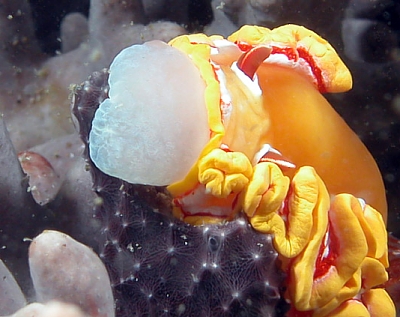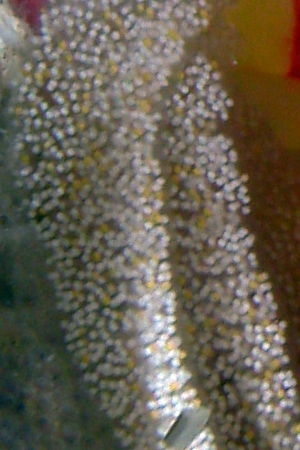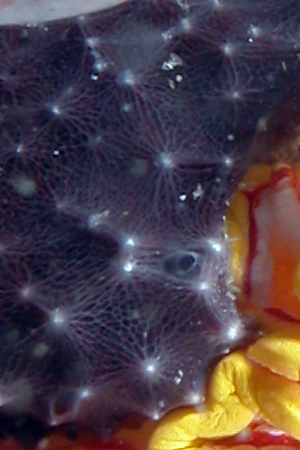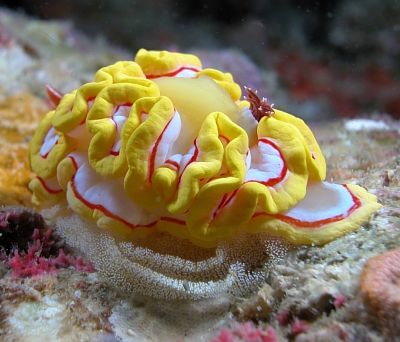Glossodoris rubroannulata - natural history [1]
August 31, 2007
From: David Mullins

Dear Bill,
I thought the forum might appreciate some behavioural records of Glossodoris rubroannulata Rudman, 1986.
This beautiful species,always a joy to photograph,is regularly sighted here on the Sunshine Coast. I have many gorgeous portraits of this nudibranch but no doubt the readers are more interested in those that add to our resource of knowledge. The photos demonstrate feeding and spawning. The spawn seems to exhibit the extra-capsular yolk that you have mentioned previously with other species. This specimen was located beneath a dead coral head.
Locality: Upper photo: [showing feeding] "Trench", Mooloolaba, 18 metres, Queensland, Australia, Pacific Ocean, 14 January 2006, Rocky Reef. Length: 75 mm. Lower photo: [showing egg-laying] "Wait-a-while", Gneering Shoals, Mooloolaba, Queensland, Australia, Pacific Ocean. Depth: 14 metres. Length: 80 mm. 14 June 2004. Photographer: David Mullins.
Kind regards,
David Mullins.
david@nudibranch.com.au



Dear David,
I sometimes think I sound like a squeaky wheel always asking for photos of these animals 'doing things' but your message perfectly illustrates the value of learning more about their biology and natural history. Althought it is vital to know their anatomical details, and I have spent my career looking at anatomical details, sometimes there just don't seem to be sufficient differences to be sure just what is going on. So looking at things like egg ribbons and feeding behaviour can give us another suite of characters to consider.
As Nerida Wilson has shown [#8611], chromodorids which lay a flat egg ribbon are almost certainly a separate phylogenetic group to other species of Chromodoris that don't. And my recent feeding review [#20272] shows that these flat-egg producing chromodorids also feed on different sponges as well.
Which brings me to your animals. Glossodoris is another genus with some puzzling anatomical subgroups, and G. rubroannulata belongs to one subgroup with similarities to 'Chromodoris'. Your discovery of this egg ribbon with extra-capsular yolk is interesting, because up until now species of Chromodoris, but not species of Glossodoris, have been reported to have this type of egg ribbon [see Fact Sheet]. The other interesting thing is the sponge your animal is eating. Species of Glossodoris seem to feed exclusively on thorectid sponges, and this is not a thorectid. I am pretty sure I know what it is but I am sending it off to Pat Bergquist for a definitive identification. It seems from your observations that we will need to seriously consider whether G. rubroannulata is indded a Glossodoris.
Thanks again for these interesting finds
Best wishes,
Bill Rudman
Related messages
-
Re: Glossodoris rubroannulata from nthn New South Wales
From: Leanne & David Atkinson, August 31, 2007 -
Glossodoris rubroannulata - more feeding pics
From: David Mullins, August 31, 2007 -
Glossodoris rubroannulata - more pics spawning?
From: David Mullins, August 31, 2007 -
Glossodoris rubroannulata - natural history [2]
From: David Mullins, August 31, 2007 -
Glossodoris rubroannulata from Jervis Bay
From: Sue Newson, March 29, 2006 -
Glossodoris rubroannulata from nthn New South Wales
From: L. & D. Atkinson, November 30, 2005 -
Glossodoris rubroannulata from southern Queensland
From: Rachel Murphy, November 25, 2005 -
Glossodoris rubroannulata in Sydney?
From: David Power, May 20, 2005 -
Glossodoris rubroannulata from Sydney
From: Akos Lumnitzer, September 30, 2002 -
Found at Mooloolaba
From: Wayne Ellis, May 26, 1998
